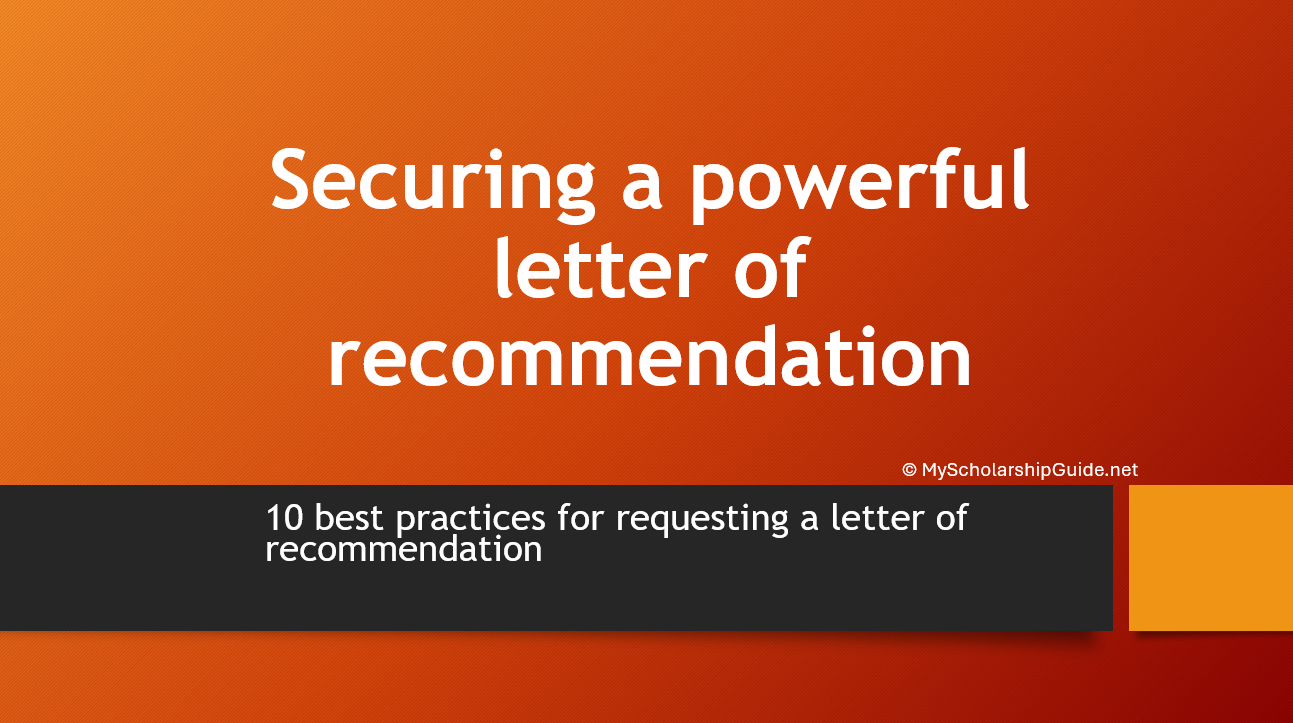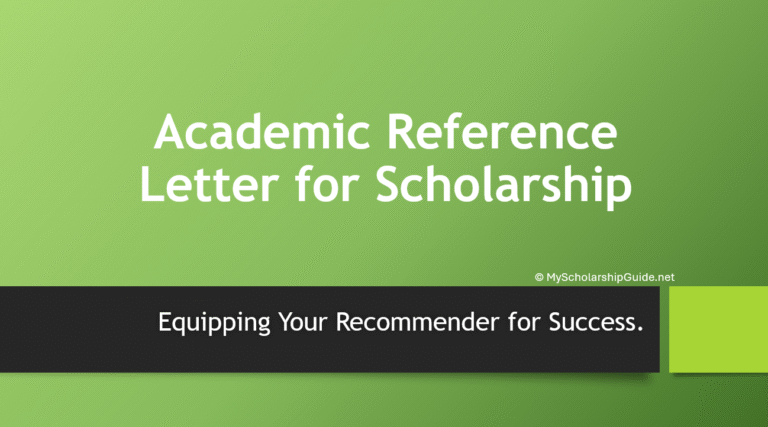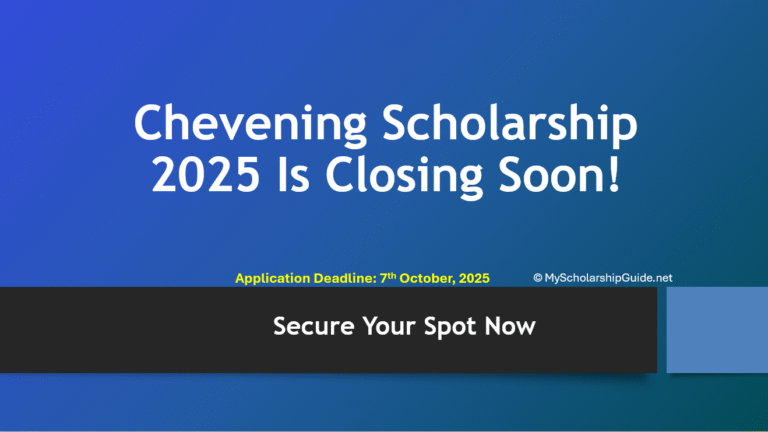How to Get a Letter of Recommendation: 10 Best Practices for African Students
How to Get a Powerful Letter of Recommendation: 10 Best Practices for African Students
You’ve spent countless hours perfecting your personal statement, polishing your CV, and researching the perfect scholarship. You feel confident, but then you get to the application requirement that makes your heart sink: the letter of recommendation. For many African students, this can be the most intimidating part of the entire scholarship application process.
You know that a generic, lukewarm recommendation can sink your chances, no matter how good the rest of your application is. But how do you ensure your recommenders write a letter that truly stands out? A letter that captures your unique potential, work ethic, and achievements?
This article is your comprehensive guide to mastering the art of requesting a letter of recommendation. We will walk you through a step-by-step process, from selecting the right recommender to providing them with everything they need to write a powerful, compelling letter. We will cover the 10 best practices for requesting a letter of recommendation, all tailored to help you secure that life-changing scholarship. By the end of this guide, you will have a clear, actionable plan to transform this stressful task into a strategic advantage.
1. Choose Your Recommenders Strategically: Quality Over Quantity
The first and most critical step in this process is selecting the right people to vouch for you. It’s a common mistake to simply choose the most senior person you know. A generic letter from a high-ranking official who barely knows you is far less effective than a detailed, specific letter from someone who has worked with you closely.
Who is the “Right” Recommender?
- Someone who knows you well: This is the most important factor. Choose a professor who taught you in a few classes, a supervisor who oversaw your work on a specific project, or a mentor you’ve worked with for a significant period. They should be able to speak about your character, skills, and potential with concrete examples.
- Someone with a relevant perspective: If you are applying for a master’s in engineering, a recommendation from your engineering professor is more valuable than one from your history professor. The recommender’s perspective should align with the program or scholarship you are applying for.
- Someone who is a strong writer and is reliable: This can be difficult to gauge, but you want to select someone who you trust to meet deadlines and communicate clearly. The letter itself needs to be well-written.
During my time, I asked my former employer to be my reference. He agreed immediately because we already had a good rapport. This highlights the importance of establishing a positive relationship with your bosses.
2. Give Ample Notice (Minimum 3-4 Weeks)
You should never, ever send an email with the subject line “Urgent Recommendation Needed!” It’s disrespectful and puts your recommender in an awkward position. Professors and supervisors are busy people, often juggling many requests. Giving them a generous timeline shows respect and ensures they have enough time to write a thoughtful, high-quality letter.
The Power of Planning Ahead
- Plan your schedule: As soon as you decide to apply for a scholarship, make a list of potential recommenders and the deadlines.
- Initial contact: Reach out at least a month before the first deadline. This gives them time to agree to the request, and then you can follow up with your materials.
- The “No” is also a possibility: By giving enough notice, you also give them an opportunity to politely decline if they don’t have the time or feel they can’t write a strong letter. This is a good thing! It allows you to find an alternative without panic.
3. Ask Directly and Politely: The “Are You Able to Write a Strong Letter?” Question
When you make the initial request, you should do so in a way that gives them an easy out. This is a critical step in the 10 best practices for requesting a letter of recommendation. Don’t just ask, “Will you write me a letter?” Instead, ask a more specific and leading question.
How to Phrase the Request
- Start with gratitude: “Hello Professor [Name], I hope you are doing well. Thank you again for the knowledge and guidance you provided in your [Course Name] class.”
- Make the request specific: “I am applying for the [Scholarship Name] at [University Name] with a deadline of [Date]. I was hoping you might be willing to write a letter of recommendation for me.”
- Add the magic word: “strong”: “I was wondering if you would feel comfortable writing me a strong letter of recommendation?” This phrase is key. It prompts them to consider if they truly have enough positive things to say about you. If they hesitate or say they are too busy, it’s a polite signal for you to look elsewhere.
4. Prepare a Comprehensive Recommender Packet
Your job is to make your recommender’s life as easy as possible. You want them to spend their time writing, not searching for information about you. A well-organized packet is a powerful tool. This is a cornerstone of the 10 best practices for requesting a letter of recommendation.
What to Include in Your Recommender Packet
- Your CV/Resume: An updated version of your curriculum vitae.
- Your Personal Statement/Statement of Purpose: This is crucial. It gives them context for your career goals and why you are applying to this specific program. They can then tailor their letter to align with your narrative.
- A “Brag Sheet” or a list of key achievements: This is a one-page document where you highlight 3-5 specific, relevant accomplishments from your time with them.
- Example: “In your ‘Environmental Economics’ class, I wrote a research paper on the economic impact of deforestation in the Congo Basin, where I earned the highest grade in the class.”
- Example: “As an intern under your supervision at [Company Name], I led a team that successfully implemented a new data management system, which reduced processing time by 15%.”
- The link to the scholarship or program: This allows them to see the official requirements and learn more about the opportunity.
- Specific instructions for submission: Clearly state if the letter needs to be uploaded to a portal, emailed to a specific address, or sent by post. Include any required forms.
- The deadline: Put the deadline in bold and specify the time zone (e.g., November 30, 2025, at 5 PM EST).
5. Follow Up and Gently Remind Them of Deadlines
You’ve given them all the information, but it’s still your responsibility to ensure the letter is submitted on time. This is not about being a pest; it’s about being proactive and respectful of their time.
The Gentle Reminder Process
- Initial confirmation: After they agree, send a polite follow-up email with all the materials attached. Something like, “Thank you so much for agreeing to write the letter! I have attached all the materials you requested. Please let me know if you need anything else.”
- The two-week check-in: A friendly email two weeks before the deadline. “Hello Professor [Name], I hope you are having a productive week. I wanted to gently remind you that the deadline for my [Scholarship Name] application is in two weeks, on [Date]. Please let me know if you’ve had a chance to start the letter or if you have any questions.”
- The “one week left” note: If you still haven’t heard anything, another polite email a week before the deadline is appropriate. “Just a friendly reminder that the deadline for the [Scholarship Name] is coming up next [Day of the week]. I really appreciate your support.”
6. Tailor Your Request for Each Application
Many students make the mistake of asking for one generic letter of recommendation and then using it for all their applications. This is a huge missed opportunity. Each scholarship and program has different goals and looks for different qualities in a candidate.
The Importance of Customization
- Identify the program’s values: Read the scholarship’s description. Does it emphasize leadership? Research potential? Community service?
- Customize your “Brag Sheet”: For an application that values research, highlight your research paper and analytical skills. For an application focused on leadership, emphasize your role as a team leader or project manager.
- Provide specific examples: The more you can connect your achievements to the specific requirements of the program, the easier it is for your recommender to write a tailored, and thus more powerful, letter.
7. Be Prepared to Draft Your Own Letter (But Only If Asked)
In some cases, especially with very busy senior faculty, they might ask you to draft the letter yourself. While this may seem daunting, it is actually a fantastic opportunity to create a highly effective letter. It is crucial to be prepared for this possibility.
How to Handle a Self-Draft Request
- Do not assume you should do this: Only do this if they explicitly ask. Offering to write it without being asked can be seen as presumptuous.
- Write in their voice: Use a formal tone and language that sounds like it’s coming from them. Use their title (e.g., Dr. [Name]) and not their first name.
- Focus on specific details: Remember to include the specific anecdotes and achievements from your “Brag Sheet.” A well-drafted self-letter will be full of concrete examples, not just generic praise.
- Proofread meticulously: Check for any errors. The last thing you want is a poorly written letter that reflects badly on both of you.
8. Don’t Forget to Say Thank You
This step is often overlooked, but it is one of the most important of the 10 best practices for requesting a letter of recommendation. A simple thank you note or email goes a long way.
The Thank You Process
- The immediate thank you: As soon as they agree to write the letter, send a thank you email.
- The post-submission thank you: Once you know the letter has been submitted, send another thank you. “Thank you so much for taking the time to write a letter of recommendation for my [Scholarship Name] application. I really appreciate your support and help in my academic journey.”
- The final update: If you get the scholarship, let them know! This not only shows your gratitude but also gives them a sense of satisfaction in knowing they played a part in your success. It also builds a strong relationship for the future.
9. Maintain a Positive and Professional Relationship
The best letters of recommendation come from people who have a positive and professional long-term relationship with you. This is a relationship you should be cultivating long before you need a recommendation.
Building Long-Term Relationships
- Engage in their classes or projects: Ask thoughtful questions, participate actively, and show genuine interest.
- Stay in touch: A simple email after you’ve completed their course or moved on from the internship, just to say hello and give an update on your career, can keep the relationship alive.
- Ask for advice: Periodically asking for their professional or academic advice shows that you value their expertise beyond just needing a letter from them.
10. Understand What Makes a Letter of Recommendation Truly Stand Out
Ultimately, a good letter is not just a formality. It is a powerful narrative tool that can highlight aspects of your character and potential that your CV and personal statement cannot.
Key Elements of a Standout Letter
- Specific Examples: The letter should be filled with concrete stories and examples. Instead of saying, “He is a great student,” a strong letter would say, “In my ‘Advanced Microeconomics’ class, he demonstrated exceptional analytical skills by dissecting the complex supply chain of a local agricultural cooperative, a project that earned him top marks and was presented at our departmental seminar.”
- A Personal Touch: The recommender should sound like they know you. They should use your name often and speak about you with genuine admiration.
- Context and Comparison: A great recommender will often compare you to other students or professionals they have taught or worked with. For example, “In my ten years of teaching, I have only seen a handful of students with his natural curiosity and dedication to solving real-world problems.”
Frequently Asked Questions (FAQs)
Can I ask a family friend who is a professor to write a letter for me?
This is generally not a good idea. Most scholarship committees require letters to be from academic or professional supervisors who have directly observed your work and skills. A letter from a family friend, even if they are a professor, can be viewed as biased and may not hold as much weight as a letter from someone who has been your direct instructor or manager. The key is to find someone who can speak to your academic or professional abilities, not your personal character.
What should I do if a recommender says no?
Do not be discouraged! A “no” is often a blessing in disguise. It means they either don’t have the time or don’t feel they can write a strong letter for you. You would rather they decline than write a generic, unenthusiastic letter. Politely thank them for their honesty and move on to your next potential recommender. This is why having a list of potential recommenders is so important.
Is it acceptable to waive my right to see the letter of recommendation?
Yes, absolutely. In fact, it is highly recommended. Almost all online application portals will ask if you waive your right to view the letter. Waiving this right signals to the admissions committee that the letter is a candid and honest assessment of your abilities, and it helps to build trust. Recommenders may also feel more comfortable writing a truly honest and detailed letter if they know you won’t be reading it.
What if the deadline is approaching and my recommender hasn’t submitted the letter?
First, don’t panic. Gently send a final reminder a few days before the deadline. It can be a simple, “Hello Professor, just a final friendly reminder that the deadline is this Friday. Please let me know if you’ve run into any issues with the submission portal.” If the deadline passes and the letter still hasn’t been submitted, check the scholarship’s policy. Some will accept late letters, while others will not. In the future, always have a backup plan and an alternative recommender in mind.
Your Next Steps to Success
Securing a powerful letter of recommendation is a critical component of a winning scholarship application. You now have a clear, actionable plan built on the 10 best practices for requesting a letter of recommendation. The process isn’t just about asking; it’s about strategic planning, clear communication, and making your recommender’s job as easy as possible.
Your next step is to take action. Make a list of your potential recommenders today. Draft your “Brag Sheet” with specific examples of your accomplishments. Prepare your recommender packets. The sooner you start this process, the more likely you are to receive a recommendation that truly highlights your unique strengths and helps you stand out from the competition. Go and get that scholarship—you deserve it.
Disclaimer
Unless otherwise stated, www.myscholarshipguide.com is not affiliated with any of the scholarship providers listed on our website, nor do we process applications on behalf of any organization. The content provided is for informational purposes only, and visitors are encouraged to use this information at their own discretion.







